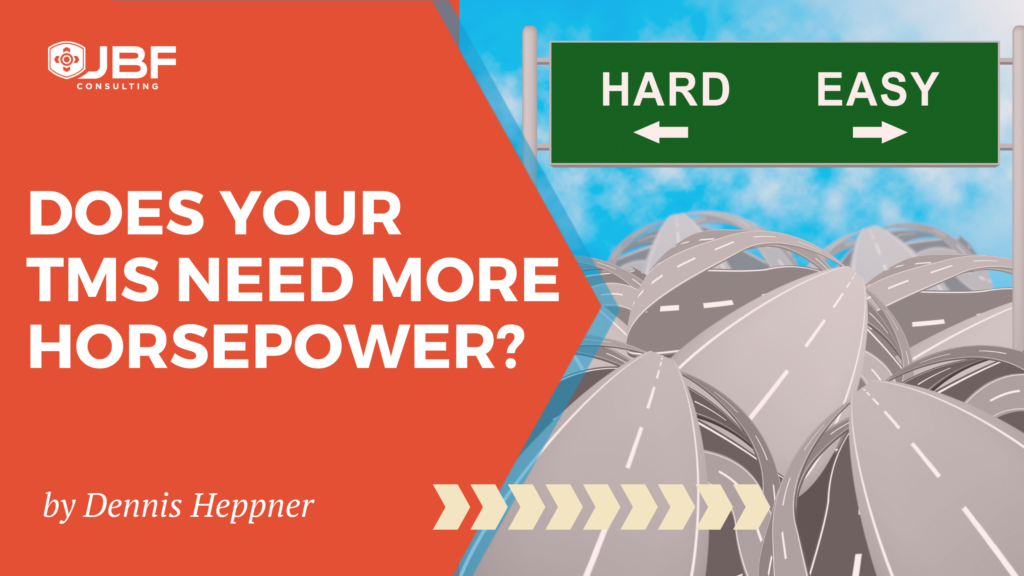Is Your TMS performing to Your Expectations?
Imagine that you bought a brand new, first model year high-end sports car many years ago (pick any make and model that gets you excited). You did your research, you asked friends for recommendations, you vetted dealers, you determined what options you required (and maybe some that were ‘nice to haves’), you knew your price point, and you went all in on the purchase.
Fast forward several years. That wonderful new car smell has worn off and you begin to notice a few things aren’t quite what they once were. Acceleration has become a little choppy; handling is looser than it should be; fuel efficiency has dropped. Maintenance has been performed as recommended, but you just are not as happy as you once were.
You find yourself at a crossroads - do you invest in some repairs and upgrades knowing that may or may not address your issues. Or do you start the process all over looking for a new vehicle?
Many factors go into the decision. Have your needs changed (the family has grown or you are now working from home)? Should your dollars be put into your home or savings account instead of the car? Maybe hobbies have changed and you would like to go off-road and be able to haul lots of gear.

“Post-implementation of a Transportation Management System (TMS) can be fraught with nagging questions about performance, value, and appropriateness of the system in the current business environment.”
Perhaps this is an overly simple story. Yet many shippers go through a similar evolution.
Post-implementation of a Transportation Management System (TMS) can be fraught with nagging questions about performance, value, and appropriateness of the system in the current business environment. We know businesses are dynamic and no one can anticipate every eventuality. Customers, vendors, and lanes change. Mergers and acquisitions occur. Service expectations become more demanding. And darn it, sometimes the TMS is just not delivering the results we once had or expected to realize.
What to do?
Putting people, organization and processes aside for the moment, let’s look at two options.
We can ‘Bandaid’ the legacy system. However, legacy TMS systems often don’t provide the transparency and visibility you need to monitor shipments, optimize routes, lower costs and improve efficiencies. What sufficed for customers in the past probably doesn’t cut it today. The “Amazon-effect” is real, especially now. Customers have become accustomed to delivery options and visibility to their orders. It’s up to you to meet these heightened customer expectations.

“To compete in the modern supply chain where visibility and flexibility are key, you may need to implement a cloud-based TMS.”
A complete replacement is another path. Of course, this will be much more involved, not unlike the initial buy - define needs, research, vet, select, implement. To compete in the modern supply chain where visibility and flexibility are key, you may need to implement a cloud-based TMS. This offers faster start-up than on-prem, lower usage costs, greater flexibility and rapid return-on-investment (ROI). Lower maintenance and support costs are a big plus, too.
There are at least three key attributes you should look for when investigating todays’ offerings (your requirements may be different):
- Scalability: a modern TMS will be flexible enough to scale either with your implementation requirements (e.g., by geography or business unit) or your forecasted growth and complexities.
- Supply chain visibility: from the dock to final mile delivery we, and our customers, want an answer to “where’s my stuff?”
- Connectivity: carriers, suppliers, distribution partners, point solution vendors all should be part of our logistics ecosystem tailored to our needs.
We have seen clients exceed the business case for a new TMS and make huge leaps forward in performance and service across the organization, not just logistics. The old mantra “if it ain’t broke, don’t fix it” doesn’t work when it comes to logistics technology.
It may be painful to mothball that jazzy sports car that still gets you from point A to point B. But, a new vehicle, loaded with options that were not even offered when you bought previously, will better serve your needs, is more efficient, and will make the family happier.
Dennis Heppner is a Principal at JBF Consulting. Dennis’ expertise in transportation, logistics and supply chain operations, and third-party providers spans 25+ years. His experience is broad-based, spanning entire supply chains, including business process redesign, sourcing, distribution network design, transportation management, distribution operations, outsourcing selection, and business strategy for major manufacturers, distributors, retailers including eCommerce, and service organizations.
About JBF Consulting
Since 2003, we’ve been helping shippers of all sizes and across many industries select, implement and squeeze as much value as possible out of their logistics systems. We speak your language — not consultant-speak – and we get to know you. Our leadership team has over 70 years of logistics and TMS implementation experience. Because we operate in a niche — we’re not all things to all people — our team members have a very specialized skill set: logistics operations experience + transportation technology + communication and problem-solving skills + a bunch of other cool stuff.


